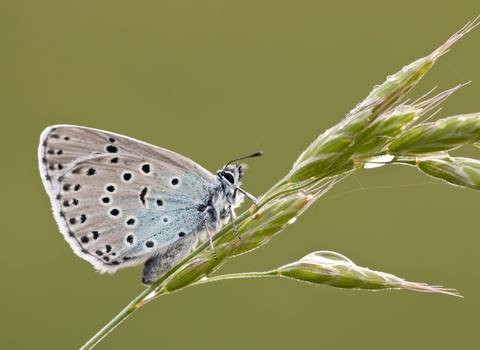
Large Blue ©Ross Hoddinott/2020VISION

Large Blue ©Andrew Kerr
Large blue
Despite its name, the large blue is a fairly small butterfly, but the largest of our blues. It was declared extinct in 1979, but reintroduced in the 1980s and now survives in southern England.
Scientific name
Maculinea arionWhen to see
June to JulySpecies information
Category
Statistics
Wingspan: 3.8-5.2cmProtected in the UK under the Wildlife and Countryside Act, 1981. Priority Species under the UK Post-2010 Biodiversity Framework. European Protected Species under Annex IV of the European Habitats Directive. Listed as Near Threatened on the global IUCN Red List of Threatened Species.
A coordinated programme to protect the large blue runs in the south of England. The Wildlife Trusts are one of a number of partners involved in ensuring proper management of grassland sites and monitoring of populations.
A coordinated programme to protect the large blue runs in the south of England. The Wildlife Trusts are one of a number of partners involved in ensuring proper management of grassland sites and monitoring of populations.
About
The large blue is the biggest blue butterfly. Adults fly for a very short period from the end of June to the beginning of July. It has always been rare in the UK, but declined dramatically during the 20th century and became extinct in 1979. Reintroduced in the early 1980s, small populations are now surviving in the south of England. It breeds in warm, dry, unimproved grasslands, such as coastal or limestone grasslands.How to identify
The large blue is a fairly dark blue butterfly with thick, dark grey wing borders and large dark spots on the forewings. It is larger than the other blue species, and only found at a handful of sites.Distribution
A very rare butterfly, found at only a handful of sites in the south of England where it has been reintroduced.Did you know?
The large blue has a very strange lifecycle. The caterpillars first feed on wild thyme, but then drop onto the ground and are carried away by ants who mistake them for ant grubs and return them to their nest. Here, the caterpillars feed on the ant grubs themselves, rapidly growing in size before turning into chrysalises.Watch
Large blue butterfly (https://vimeo.com/427873240)
Large blue butterfly © Tom Hibbert
